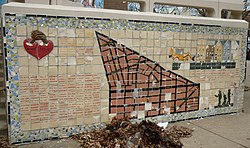In the decades preceding Philadelphia's consolidation in 1854, the area was home to taverns and businesses catering largely to the stagecoach and cattle droving trades. After the Civil War, it developed into one of West Philadelphia's affluent streetcar suburbs. The University of Pennsylvania moved there in 1870. After World War I, wealthier residents moved further west into West Philadelphia and its suburbs, leaving neighborhoods in eastern West Philadelphia in decline. The relative availability of cheap housing in the area attracted many African Americans, including migrants from the Southern States, who faced housing discrimination elsewhere in the city.
Urban renewal
The University of Pennsylvania had expanded as far north as Walnut Street by 1920, but in 1959, Penn, Drexel University, University of the Sciences in Philadelphia, and Presbyterian Hospital sought to create large-scale redevelopment in the area to eradicate blight and develop a "University City" neighborhood of residences and services for students, faculty and staff. Together, they created the West Philadelphia Corporation and acquired large numbers of properties for demolition.
The first major clash between Black Bottom residents and the white institutions came in 1963, over the plans to build a science magnet high school on 7.6 acres of land in Unit 3 between 36th and 38th Streets, along Market Street (Reid et al, 1997). Black residents believed that very few of their children would gain entrance to the magnet school, which was being designed for the children of the faculty, staff, and graduate students of Penn and Drexel. Construction of the magnet school, to be called University City High School, would also displace families and individuals living in that section of Area 3. [7]
Portions of the area were eventually declared blighted by the city, and remaining properties were purchased by eminent domain. The final buildings were demolished by the late 1960s. The number of displaced residents is estimated between 4,496 and 15,000 by various sources.
Former Black Bottom residents celebrate Black Bottom Day on the last Saturday in August in Fairmount Park.

